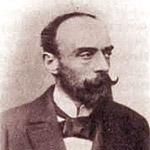Riccardo Selvatico
Riccardo Selvatico (born April 16, 1849 in Venice ; † August 21, 1901 in Biancade , a frazione of Roncade ) was Mayor of Venice from April 12, 1890 to 1895. Filippo Grimani succeeded him in office in 1895 .
Life
Selvatico was born in Venice and initially taught privately. From 1890 to 1895 he attended the liceo Santa Caterina , later Marco Foscarini . He studied at the University of Padua until 1873. He married Anna Maria (Nina) Charmat, with whom he had two sons, namely Lino (1872-1924) and Luigi (1873-1938), who were both painters.
Selvatico enjoyed a great reputation in Italy as a writer of comedies and as a poet. The former included La bozeta de l'ogio and I recini da festa . After he was elected mayor (sindaco), he was often referred to as "sindaco-poeta".
In 1890 he was elected mayor of Venice as part of the progressive party, an office he held until 1895. A moderately clerical group opposed him in a media campaign against his secular city regiment. Selvatico was accused of promoting atheism and socialism , especially since in Venice, starting from Genoa in 1892, the Socialist Party was founded and a Camera del Lavoro was created for the first time , which bundled the forces of the various unions and gave them a common organizational structure. In 1894, the government under Francesco Crispi enforced exceptional laws against the socialists.
The new city government also strengthened welfare organizations, reformed the school system, banned prayers in schools, gave more women access to education and training and tried to provide healthier and cheaper housing by setting up the Commissione per la costruzione di case sane ed economiche in 1893 founded a 'Commission for the Construction of Healthy and Cheap Housing'. In addition, the idea of a high school for architecture (Scuola superiore di architettura) was born.
Selvatico adopted urban development concepts that strengthened the spatial separation of urban functions. The industrialization of the mainland ( Mestre , Marghera ) and the fixation of the core city on tourist management go back to his reign .
On April 16, 1891, the Società Italo Americana pel Petrolio (SIAP), a foreign agency of Standard Oil , was founded in Venice . In the same year, a horse-powered tram connected the old town with Mestre for the first time, and a steamboat ran through the Bacino di San Marco for the first time . On the Giudecca which originated Molino Stucky , a neungeschossiges industrial building, a brick building in the style of the north German brick Gothic .
To elevate this cultural, founded Selvatico with the support of the first Secretary General of the Biennale Antonio Fradeletto and together with a group of intellectuals such as Giovanni Bordiga 1895 Biennale he for the opening speech - although no longer mayor - held in the presence of the king. The first biennial already had 224,000 visitors, in 1909 even 437,000. From the debt burden of an exhibition that had taken place in 1887, Selvatico had drawn the consequence to include the local savings bank (Cassa di risparmio) in the financing. At a meeting on April 19, 1893, Selvatico succeeded in convincing the council members with this promise in the back of the exhibition.
Accordingly, a Herme by Selvatico, created by Pietro Canonica , can be found in the gardens of the Biennale, as is a painting by Alessandro Milesi in the Ca 'Pesaro .
Selvatico's correspondence includes numerous collections. He wrote 19 letters to Pompeo Gherardo Molmenti alone .
Selvatico was buried on the cemetery island of San Michele .
literature
- Tiziana Agostini Nordio: Venezia nell'età di Riccardo Selvatico , Venice: Ateneo veneto 2004.
Remarks
- ^ Giorgio Padoan: Problemi di critica goldoniana , Vol. 9, Longo, 2003, p. 292.
- ↑ Jan Andreas May: La Biennale di Venezia: Continuity and Change in the Venetian Exhibition Policy 1895–1948 , Berlin 2009, p. 4.
- ↑ Arne Karsten : Little History of Venice , Munich: Beck 2008, p. 245f.
- ^ Tiziana Agostini Nordio: Venezia nell'età di Riccardo Selvatico , Ateneo veneto, Venice 2004, p. 359.
| personal data | |
|---|---|
| SURNAME | Selvatico, Riccardo |
| BRIEF DESCRIPTION | Italian politician, mayor of Venice (1890–1895) |
| DATE OF BIRTH | April 16, 1849 |
| PLACE OF BIRTH | Venice |
| DATE OF DEATH | August 21, 1901 |
| Place of death | Biancade |
